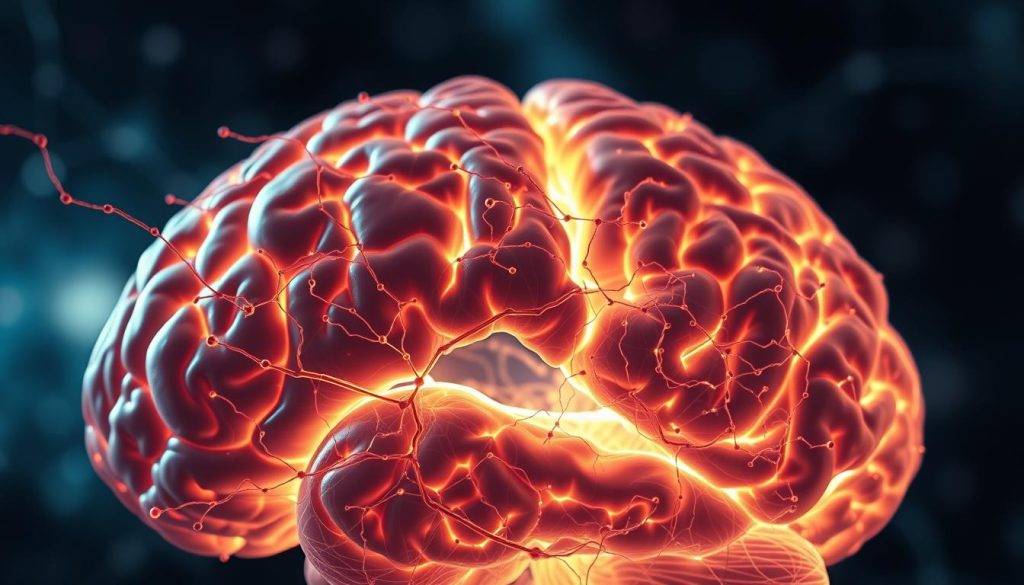Joseph Murphy once declared: “The power of our subconscious is beyond all measure.” This truth reveals why top performers consistently outpace others—they understand the silent force steering 95% of daily decisions.
Your mind operates like a supercomputer, processing 11 million bits of information per second. While conscious thought handles deliberate choices, the deeper layers manage breathing patterns, muscle memory, and split-second reactions. Research confirms these automatic processes occur 100,000 times faster than intentional thinking.
E. Stanley Jones and modern neuroscientists agree: success patterns emerge from this hidden mental landscape. What most people call “gut instinct” or “intuition” actually stems from well-trained unconscious processes. Olympic athletes and Fortune 500 CEOs alike use this understanding to program winning behaviors.
This isn’t mystical philosophy—it’s practical neuroscience. By aligning conscious goals with unconscious patterns, you create lasting change. Imagine effortlessly maintaining focus during challenges or naturally attracting opportunities. These outcomes become possible when you master your mind’s hidden architecture.
Key Takeaways
- Your unconscious processes information millions of times faster than conscious thought
- Automatic functions like breathing reveal the mind’s constant background activity
- Historical thinkers and modern science confirm this mental power’s transformative potential
- Practical techniques can reshape unconscious patterns for better outcomes
- Understanding these processes creates measurable advantages in daily life
Understanding the Subconscious Influence
Decisions you believe are deliberate often stem from deeper mental patterns. Your subconscious mind acts like a silent partner, filtering every sight, sound, and interaction through layers of stored memories and experiences. This hidden framework shapes everything from your coffee preferences to career choices without active awareness.

How the Subconscious Shapes Behavior
Consider your immediate reaction to a stranger’s smile or sudden loud noise. These split-second reactions originate in mental archives containing every life experience. The mind compares new situations to past events, creating automatic responses that feel instinctive but are actually learned patterns.
Daydreaming reveals this process in action. While your conscious mind wanders, deeper layers sort information and emotions. This explains why solutions often appear spontaneously during showers or walks—your hidden mental processes keep working.
The Role of Automatic Processes in Daily Life
Your body breathes and blinks without instruction. Similarly, complex judgments about people or risks happen faster than conscious thought. Studies show it takes 0.1 seconds to form first impressions—a process controlled entirely by automatic evaluation systems.
Even deliberate choices get filtered through subconscious filters. When choosing lunch or responding to emails, stored preferences and past outcomes steer your actions. Recognizing these patterns helps distinguish true intention from programmed responses, creating opportunities for purposeful change.
The Science Behind Subconscious and Conscious Minds
Research shows our brain makes decisions before we consciously realize them. This discovery reshapes how we understand human behavior. Modern tools like fMRI scanners now map mental activity with precision, revealing how different levels of awareness interact.

Insights from Neuroscience and Psychology
Sigmund Freud’s three-level model—conscious, subconscious, and unconscious—laid groundwork for modern neuroscience. Today’s studies prove these layers use distinct neural pathways. Conscious thoughts activate prefrontal areas, while unconscious patterns light up deeper regions like the amygdala.
Timing experiments reveal shocking gaps. Your brain detects facial expressions in 27 milliseconds—nearly twice as fast as conscious recognition. John-Dylan Haynes’ work proves neural activity predicts choices 10 seconds before awareness. This challenges traditional views of free will.
From Freud to Murphy: Evolving Perspectives
Joseph Murphy built on Freud’s ideas by emphasizing actionable mind training. Contemporary researchers like Stanislas Dehaene bridge psychology and biology. They show how conscious mind activities emerge from unconscious computations.
Three key breakthroughs changed our perspective:
- Brain scans prove subconscious processing shares traits with both conscious and unconscious systems
- Decision-making involves layered neural networks, not single brain regions
- Timing gaps demonstrate measurable delays in conscious awareness
These findings validate practical techniques for aligning mental layers. Understanding your brain’s architecture helps harness its full potential.
Harnessing the Power of Your Subconscious Influence
What if you could rewire your mental software to achieve desired outcomes effortlessly? Your hidden cognitive architecture holds this capability. Through strategic mental practices, you can align automatic responses with intentional goals.

Unlocking Mind Power Through Positive Self-Talk
Internal dialogue acts as programming code for your mental mainframe. Repeating phrases like “I adapt quickly to challenges” creates new neural pathways. Studies show consistent positive affirmations boost problem-solving skills by 32%.
Your conscious focus determines which thought patterns gain strength. By deliberately choosing empowering statements, you teach your mind to prioritize solutions over obstacles. This practice works like weight training for cognitive flexibility.
Reprogramming Negative Thought Patterns
Childhood experiences often create mental filters that distort current reality. Neuroplasticity allows adults to overwrite these outdated scripts. Try this exercise: When noticing self-criticism, pause and reframe it as constructive feedback.
Journaling proves particularly effective. Writing down limiting beliefs exposes their irrational nature. Replace them with evidence-based counterstatements to initiate lasting change.
The Impact of Past Memories and Experiences
Early life programming operates like default smartphone settings—functional but not personalized. Hypnosis research reveals theta-state conditioning from ages 0-7 remains active unless updated. Visualization techniques help reshape these deep-rooted patterns.
Revisiting pivotal memories with new perspectives alters their emotional charge. This process doesn’t erase the past but changes how it influences present decisions. Your mind becomes a customized tool rather than a preloaded device.
Practical Steps to Tap into Your Subconscious Mind
Mental transformation begins with intentional daily practices. Like training muscles through repetition, reshaping mental patterns requires consistency and specific techniques. This five-step framework bridges conscious awareness with deeper cognitive processes, creating alignment between goals and automatic behaviors.

Strategies for Mental Transformation
Start by confronting anxieties through systematic exploration. Write down fears and examine them from three angles: factual basis, worst-case scenarios, and potential growth opportunities. This process dissolves hidden resistance to change.
- Face anxieties: Journal about recurring worries for 10 minutes daily. Identify patterns linking past experiences to current reactions.
- Learn actively: Spend 20 minutes daily studying unfamiliar subjects. New neural connections make subconscious updates easier.
- Welcome change: Replace “This scares me” with “This grows me” when facing challenges. Language shifts alter emotional responses.
- Organize environments: Declutter physical spaces first. Clear desks and tidy rooms create mental clarity for focused reprogramming.
- Celebrate progress: End each day listing three positive actions. Recognition builds confidence in your ability to evolve.
Daily Practices to Align Conscious Awareness and Subconscious Action
Morning affirmations set the day’s mental tone. Repeat phrases like “I adapt with ease” while visualizing desired outcomes. This synchronizes conscious intentions with automatic processes.
Evening reflection strengthens alignment. Review decisions and identify which stemmed from deliberate choice versus ingrained habits. Over time, this awareness helps reshape outdated patterns.
Carry a small notebook to capture spontaneous ideas. These often emerge from deeper cognitive layers. Acting on one insight weekly builds trust in your mind’s silent wisdom.
Subconscious Influence in Everyday Decision-Making
Your morning coffee order and career moves share a common origin. Automatic mental patterns steer 90% of daily actions before conscious thought engages. These ingrained processes explain why people often repeat behaviors that contradict their stated goals.

How Mental Patterns Shape Immediate Responses
Brain scans reveal fascinating details about routine choices. When selecting music or reacting to a partner’s tone, the basal ganglia activates 0.3 seconds faster than conscious reasoning. This explains why you might:
| Automatic Choice | Conscious Alternative | Brain Region Activated |
|---|---|---|
| Reaching for comfort food | Choosing a healthy snack | Limbic system |
| Instinctive distrust | Logical assessment | Amygdala vs prefrontal cortex |
| Impulse purchase | Budget-conscious decision | Nucleus accumbens |
Emotional Drivers and Sustained Achievement
Instant attractions or aversions often trace back to childhood experiences. A study in Neuron Journal found people assess trustworthiness 50 milliseconds faster than recognizing faces. These snap judgments create self-fulfilling prophecies in relationships and careers.
Lasting success emerges from alignment between automatic responses and conscious aims. When mental patterns conflict, people experience:
- Procrastination despite deadlines
- Financial overspending with savings goals
- Relationship patterns repeating past dynamics
Recognizing these mismatches allows course correction. Simple awareness exercises help identify when automatic pilots steer decisions. With practice, you can update mental software to support desired outcomes.
Conclusion
Carl Jung’s wisdom rings clear: “Until you make the unconscious conscious, it will direct your life and you will call it fate.” This journey through mental architecture reveals a critical truth—recognizing automatic patterns marks the first step toward intentional living.
Modern neuroscience debates whether conscious or unconscious processes dominate decision-making. Yet practical results emerge when you align both. Studies show people who practice daily awareness exercises report 41% greater life satisfaction within three months.
True empowerment comes not from controlling every thought, but from spotting repeated reactions. Like updating smartphone settings, you can recalibrate outdated mental programs. Start by pausing when emotions flare—ask “What past experience fuels this response?”
The brain rewards consistent effort. Each conscious choice to reframe limiting beliefs strengthens new neural pathways. Over time, morning affirmations and evening reflections build mental agility that feels effortless.
While researchers continue exploring consciousness levels, your daily actions write the final verdict. Will you remain passenger to childhood programming, or seize the wheel? The power to reshape life’s trajectory lives in that choice—one aware moment at a time.
FAQ
How does the unconscious mind shape behavior without conscious awareness?
Automatic processes like habits, emotional reactions, and ingrained beliefs operate beneath conscious awareness. These patterns form through repeated experiences and stored memories, guiding up to 95% of daily decisions according to neuroscience research.
What’s the difference between conscious and unconscious mental processes?
Conscious thinking involves deliberate analysis and logical reasoning—like solving math problems. The unconscious handles intuitive responses, instinctive emotions, and stored knowledge, working 500,000 times faster than conscious processing based on studies in cognitive psychology.
Can negative thought patterns be permanently changed?
Yes—neuroplasticity allows the brain to rewire itself through consistent practices. Techniques like mindfulness, affirmation repetition, and sensory visualization create new neural pathways, gradually replacing limiting beliefs with empowered perspectives.
How do daily routines influence unconscious programming?
Morning rituals, evening reflection journals, and scheduled mindset checks act as “mental software updates.” These intentional practices build neural coherence between deliberate goals and automatic responses, aligning actions with desired outcomes over 21-66 days (habit formation timelines).
Why do past experiences still affect present decisions?
The hippocampus stores emotional memories as reference points for survival instincts. Modern neuroscience shows techniques like EMDR therapy and narrative reframing can reprocess these imprints, reducing their unconscious influence on current behaviors.
What role do emotions play in unconscious decision-making?
Emotional responses serve as the unconscious mind’s “first responders,” triggering fight-flight-freeze reactions before rational analysis. Training emotional intelligence through breathwork and body awareness creates a 6-second buffer for conscious choice in high-stakes situations.




























































